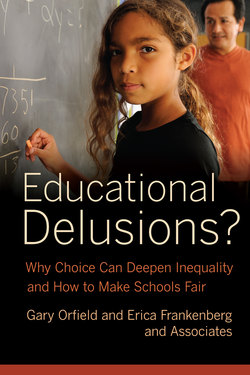Читать книгу Educational Delusions? - Gary Orfield - Страница 7
На сайте Литреса книга снята с продажи.
ОглавлениеACKNOWLEDGMENTS
Choice has been a major theme in civil rights policy since the 1960s. One of us, Erica Frankenberg, is the product of a good desegregated magnet school in Mobile, Alabama; the other, Gary Orfield, had his children attend a magnet school in Illinois and was deeply involved in the creation of new magnet schools in St. Louis and San Francisco, where federal courts appointed him as special master in each district's desegregation case. He was also one of the conveners of a faculty seminar at Harvard on choice and diversity, and a number of Civil Rights Project studies of desegregation and No Child Left Behind have discussed this issue. In fact, this book originated from a series of discussions after the February 2010 release of the Civil Rights Project report Choice without Equity, which describes the intense segregation of charter schools at a time when federal policy was strongly promoting them as a centerpiece of its reform agenda. Our study stimulated intense national debate. We concluded that as all states faced growing federal pressure to implement choice programs, it was time to bring together the latest research and to reflect on where the country is going and what issues a variety of experiences show need to be considered in making decisions about choice strategies.
We are especially grateful to Naomi Schneider at University of California Press, who saw that the issue of school choice from a civil rights perspective might have the makings of an important book. It has been a pleasure to work with her and the excellent staff at the press, who pressed us to explain, to document, and to condense the studies. Our intent was to produce a volume that would be accessible and based on clear evidence to help readers critically assess assumptions about school choice and the civil rights implications of the choices and decisions being made in their communities. Because much of the debate in this arena is ideologically driven, we grounded our examination in specific cases as a way to illustrate the relationships between policies and their effects on segregation and opportunity for poor and minority families, evidence from which readers could draw their own conclusions about school choice. The coverage of many of the topics we thought were important in such a volume—charter schools, magnet schools, and controlled choice plans—began as Civil Rights Project reports, but other chapters began as reports for other organizations, including the Institute for Race and Poverty at the University of Minnesota, the Charles Hamilton Houston Institute at Harvard University, and the Warren Institute at the University of California at Berkeley. Researchers at various universities wrote each of these reports. We reached out to these authors and to other colleagues. Happily, they all agreed to participate, even with a condensed editing timeline, and to make the chapters speak to the themes of the book and to be more accessible and consistent in tone. We have contextualized these individual studies with chapters on the history of choice and civil rights, the theoretical arguments for choice, and a conclusion suggesting strategies for choice more likely to realize civil rights objectives of access and equity for students of color.
Although we wrote most of the chapters in whole or in part, we were also honored to work with excellent scholars who each contributed important independent perspectives and conclusions. Each chapter clearly shows its authorship, as does the table of contents.
In addition to Naomi's suggestions, we appreciate those of two reviewers and of Carolyn Peele to clarify our meaning. Laurie Russman, Kyra Young, Tiffanie Lewis, and Jennifer Ayscue provided research and logistical support to help bring the manuscript to publication. Alison Tyler assisted with the proofreading.
The Civil Rights Project has focused on educational equity for sixteen years, during a time when school choice has rapidly grown and civil rights have receded. We think the growth of many contemporary forms of choice has occurred in such a manner as to harm the civil rights of students of color, low-income students, and limited-English students, along with their families, their teachers, and many of their communities. The growth of choice is also challenging the efforts of school districts in some areas to provide high-quality diverse educational opportunities. We strongly believe that at the beginning of the twenty-first century, schools remain a powerful tool for attaining individual opportunity and creating a thriving multiracial democratic society. It is clear that school choice is here to stay, and we hope this book furthers the conversation about how choice policies can both stop intensifying stratification and help us widen access to quality integrated educational experiences for all U.S. students. We have been inspired by people in communities across the nation who are constantly working to expand rights and lower barriers for students.
Finally, and in many ways most importantly, we want to acknowledge the understanding, support, and love we have received in such abundance from Patricia and Mark.
Gary Orfield and Erica Frankenberg
